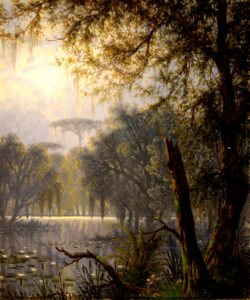Joseph Rusling Meeker
Although not a Louisiana resident, landscape painter Joseph Rusling Meeker is well known for his bayou swamp scenes.

Courtesy of Roger H. Ogden Collection
Near Point Brilliant, St. James Parish. Meeker, Joseph, R. (artist)
Joseph Rusling Meeker is not known as a Louisiana painter because of his birth or residence in the state, but because of the many sketches he made of its bayous and swamps while traveling the Mississippi River as a Union Navy paymaster during the Civil War. After the war, he settled in St. Louis, Missouri, where he gained notice by turning the drawings into paintings. Although he would go on to produce landscapes of the New England coast, the Wyoming territories, Minnesota, and the Merrimac River in New Hampshire, it is for his bayou swamp scenes, such as the painting Sunset, that he is best known. The hazy, humid atmosphere of Louisiana’s swamps and bayous is said to have influenced Meeker’s work throughout his life. The sense of mystery it suggested appealed to his romantic nature, and he was particularly attracted to the story of the eighteenth-century Acadian exiles as recounted in Henry Wadsworth Longfellow’s poem Evangeline.
Born on April 21, 1827, in Newark, New Jersey, Meeker grew up in Auburn, New York. With a scholarship to the National Academy of Design, he went to New York City in 1845 to study with the Hudson River School painter Asher B. Durand and the portraitist Charles Loring Elliott. After three years there, he made a brief return to Auburn, followed by stays in Buffalo, New York, from 1849 to 1852 and Louisville, Kentucky, from 1852 to 1859, where he gave art lessons and painted scenes of the Ohio, Kentucky, and Salt rivers.
In 1859, Meeker moved to what would be his permanent residence in St. Louis, Missouri, a city that was already a flourishing center of artistic activity. He was one of a number of artists, including Carl Wimar and Alban Jasper Conant, whose work was nurtured by the environment. In the same year as his arrival, the Western Academy of Art was founded with the purpose of forming a collection of art, founding an art school, and providing gallery space for artists to exhibit their work. In 1872, Meeker became a founding member of the St. Louis Art Society, of which he served as president for several years. He was also active in the St. Louis Sketch Club, established in 1877. At the meetings of the St. Louis Sketch Club, which were held in artists’ studios, those in attendance would make drawings based on a topic chosen by the host. Not surprisingly, when it was his studio’s turn to serve as the meeting site, Meeker selected Longfellow’s narrative poem Evangeline for sketching and discussion.
Over the years, his work was exhibited at the American Art Union and the National Academy of Design in New York City, the Boston Art Club in Massachusetts, and the Tennessee Centennial Exposition in Nashville, Tennessee. Joseph Meeker died at his home in St. Louis on September 27, 1887.
